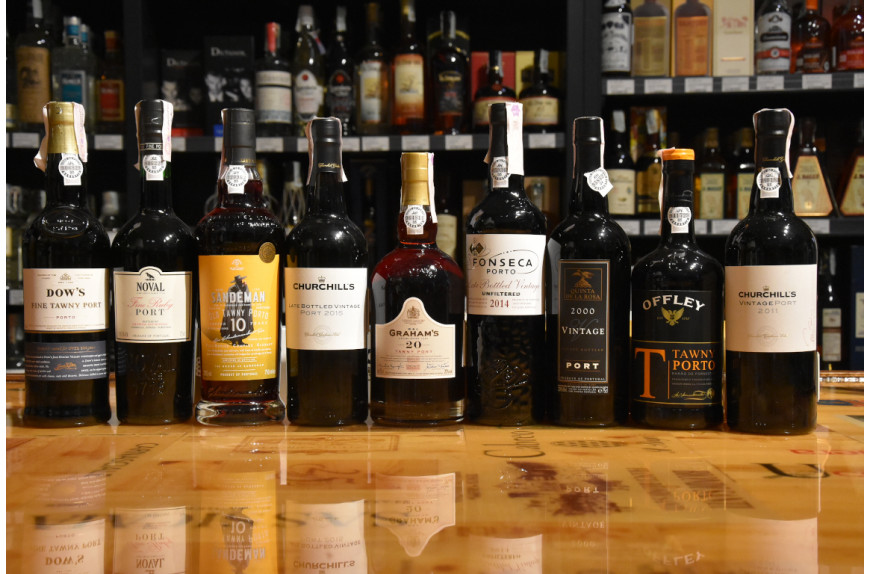Porto: the Douro red gold at the Enoteca Alessi

Porto: the Douro red gold at the Enoteca Alessi
Tags
Categorie
Porto: il vino fortificato prodotto con uve coltivate nella regione del Douro, in Portogallo.
Storia del Porto: lo zampino inglese
Il Porto prende il nome dalla città di Porto dove avviene la maturazione finale, prima di essere imbottigliato.
Le origini del Porto
Si produceva già dalla metà del XVII secolo e veniva venduto a mercanti inglesi che preferivano comprare questo vino portoghese a buon mercato e allo stesso tempo non arricchire la nemica Francia.
Proprio perché il vino doveva affrontare un viaggio in nave, i produttori del Porto iniziarono ad aggiungere alcol al mosto parzialmente fermentato, così da rendere il vino più forte e quindi più resistente agli sbalzi climatici che subiva durante il viaggio.
L’alcol aggiunto era Brandy portoghese, acquavite di vini locali.
Questa correzione non solo garantiva l’integrità del prodotto ma ne aumentava la qualità, rendendo ricco di corpo un vino inizialmente scarso di personalità che acquisiva così un retrogusto dolce ed intenso tanto da diventare uno dei vini preferiti dalla Casa Reale inglese.
La seconda fase
Nel XVIII secolo il mercato così fiorente di questo vino in tutta Europa porta i mercanti inglesi a trasferirsi in Portogallo e produrre il proprio vino Porto.
Più esattamente trovarono in Vila Nova de Gaia, di fronte a Porto, il luogo perfetto dove far maturare i vini nelle botti.
Nel 1775 vennero prodotte le prime bottiglie di Porto capaci di invecchiare e con caratteristiche simili ai vini Porto che possiamo degustare oggi.
Le aree di produzione
Al giorno d’oggi le zone ufficiali di produzione sono: Baixa Corgo, Cima Corgo, Douro Superior.
Le Quintas (aziende vinicole) devono seguire un rigido disciplinare di produzione che viene controllato dall’IVP (Instituto dos Vinhos do Douro e Porto).
Le uve consentite per la produzione sono per lo più rosse; le più importanti sono Touriga Nacional, Touriga Francesca, Tinta Cão, Tinta Roriz, Tinta Barroca.
La produzione
Dopo l’ammostamento le uve vengono messe nelle lagares e successivamente viene aggiunto alcol che blocca la fermentazione.
Dopo un piccolo periodo di stabilizzazione nelle botti, in primavera il vino viene portato a Vila Nova de Gaia.
Qui il produttore sceglierà in base alla qualità del vino che stile andrà a utilizzare: ossidativo (affinamento in legno) o riduttivo (affinamento in bottiglia).
Tipologie di Porto: giovani
Ruby: Porto giovane e semplice, prodotto con uve rosse di diverse annate, matura 3 anni in botte. Principalmente ha profumi dolci e fruttati, alla vista ha un colore rubino vivace.
Tawny: come il Ruby, è un blend di uve rosse di diverse annate ma oltre ai 3 anni di botte effettua una successiva maturazione in botti più piccole risultando alla vista più aranciato e con sentori tendenti alla frutta secca, tostati e speziati.
White: prodotto da assemblaggi di soli vini bianchi di diverse annate.
Vino più elegante e meno complesso di un rosso, va degustato giovane.
Pink: nasce dalla vinificazione in rosato delle migliori uve a bacca rossa, è un vino giovane e fruttato dalle note dolci; si presta molto bene per la preparazione di cocktail.
Tipologie di Porto: invecchiati
Porto Reserve: riportando in etichetta la menzione Reserve si indica un invecchiamento minimo di 7 anni; possono rientrare in questa tipologia il Tawny, il Ruby e il White.
Aged Tawny: Porto di stile Tawny che rimane più a lungo in botte, fino a 40 anni. Il periodo di invecchiamento verrà specificato in etichetta, ad es. 10 anos, 20 anos, 30 anos, 40 anos.
Porto Colheita: porto di stile Tawny prodotto con uve di un'unica vendemmia di ottima annata e invecchiato in botte piccola almeno 7 anni, l’annata è riportata in bottiglia.
Porto Vintage: è il Porto più importante, è un blend di uve di un’ottima annata provenienti da quintas differenti. L’annata viene riportata in etichetta.
Il Porto vintage dopo un breve passaggio in botte fa un lunghissimo affinamento in bottiglia, anche più di 20 anni, che permette al vino di avere il colore brillante di un vino giovane ma anche un eccezionale e complesso ventaglio di aromi.
Single Quinta Vintage: prodotto con uve di una sola annata e di un’unica quinta; il nome della quinta e l’annata vengono riportati in etichetta.
L’invecchiamento, come per il Vintage, è di stile riduttivo e molto lungo.
Late Bottled Vintage: prodotto con uve di una sola annata di buona qualità ma non ottima come per i Vintage. Invecchia almeno 4 anni in botte ed è un vino più immediato, da poter degustare subito a differenza di un Vintage che richiede periodi di affinamento più lunghi.
Ti aspettiamo in Via delle Oche per scegliere il Porto perfetto per te!
